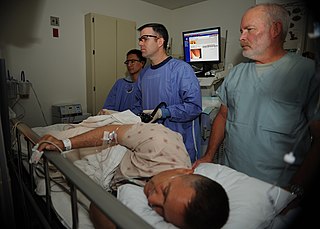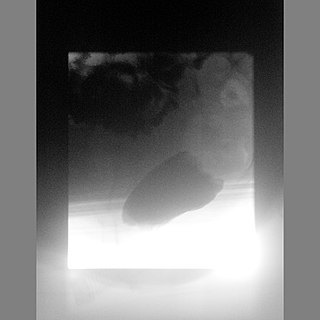Related Research Articles

Constipation is a bowel dysfunction that makes bowel movements infrequent or hard to pass. The stool is often hard and dry. Other symptoms may include abdominal pain, bloating, and feeling as if one has not completely passed the bowel movement. Complications from constipation may include hemorrhoids, anal fissure or fecal impaction. The normal frequency of bowel movements in adults is between three per day and three per week. Babies often have three to four bowel movements per day while young children typically have two to three per day.

Fecal incontinence (FI), or in some forms, encopresis, is a lack of control over defecation, leading to involuntary loss of bowel contents — including flatus (gas), liquid stool elements and mucus, or solid feces. FI is a sign or a symptom, not a diagnosis. Incontinence can result from different causes and might occur with either constipation or diarrhea. Continence is maintained by several interrelated factors, including the anal sampling mechanism, and incontinence usually results from a deficiency of multiple mechanisms. The most common causes are thought to be immediate or delayed damage from childbirth, complications from prior anorectal surgery, altered bowel habits. An estimated 2.2% of community-dwelling adults are affected. However, reported prevalence figures vary. A prevalence of 8.39% among non-institutionalized U.S adults between 2005 and 2010 has been reported, and among institutionalized elders figures come close to 50%.

Colorectal cancer (CRC), also known as bowel cancer, colon cancer, or rectal cancer, is the development of cancer from the colon or rectum. Signs and symptoms may include blood in the stool, a change in bowel movements, weight loss, abdominal pain and fatigue. Most colorectal cancers are due to lifestyle factors and genetic disorders. Risk factors include diet, obesity, smoking, and lack of physical activity. Dietary factors that increase the risk include red meat, processed meat, and alcohol. Another risk factor is inflammatory bowel disease, which includes Crohn's disease and ulcerative colitis. Some of the inherited genetic disorders that can cause colorectal cancer include familial adenomatous polyposis and hereditary non-polyposis colon cancer; however, these represent less than 5% of cases. It typically starts as a benign tumor, often in the form of a polyp, which over time becomes cancerous.

Colonoscopy or coloscopy is a medical procedure involving the endoscopic examination of the large bowel (colon) and the distal portion of the small bowel. This examination is performed using either a CCD camera or a fiber optic camera, which is mounted on a flexible tube and passed through the anus.

Digital rectal examination (DRE), also known as a prostate exam, is an internal examination of the rectum performed by a healthcare provider.

Fecal occult blood (FOB) refers to blood in the feces that is not visibly apparent. A fecal occult blood test (FOBT) checks for hidden (occult) blood in the stool (feces).

A rectal prolapse occurs when walls of the rectum have prolapsed to such a degree that they protrude out of the anus and are visible outside the body. However, most researchers agree that there are 3 to 5 different types of rectal prolapse, depending on whether the prolapsed section is visible externally, and whether the full or only partial thickness of the rectal wall is involved.

In gynecology, a rectocele or posterior vaginal wall prolapse results when the rectum bulges (herniates) into the vagina. Two common causes of this defect are childbirth and hysterectomy. Rectocele also tends to occur with other forms of pelvic organ prolapse, such as enterocele, sigmoidocele and cystocele.
In evidence-based medicine, likelihood ratios are used for assessing the value of performing a diagnostic test. They use the sensitivity and specificity of the test to determine whether a test result usefully changes the probability that a condition exists. The first description of the use of likelihood ratios for decision rules was made at a symposium on information theory in 1954. In medicine, likelihood ratios were introduced between 1975 and 1980.

A stool test is a medical diagnostic technique that involves the collection and analysis of fecal matter. Microbial analysis (culturing), microscopy and chemical tests are among the tests performed on stool samples.

Blood in stool looks different depending on how early it enters the digestive tract—and thus how much digestive action it has been exposed to—and how much there is. The term can refer either to melena, with a black appearance, typically originating from upper gastrointestinal bleeding; or to hematochezia, with a red color, typically originating from lower gastrointestinal bleeding. Evaluation of the blood found in stool depends on its characteristics, in terms of color, quantity and other features, which can point to its source, however, more serious conditions can present with a mixed picture, or with the form of bleeding that is found in another section of the tract. The term "blood in stool" is usually only used to describe visible blood, and not fecal occult blood, which is found only after physical examination and chemical laboratory testing.
Rectal bleeding refers to bleeding in the rectum, thus a form of lower gastrointestinal bleeding. There are many causes of rectal hemorrhage, including inflamed hemorrhoids, rectal varices, proctitis, stercoral ulcers, and infections. Diagnosis is usually made by proctoscopy, which is an endoscopic test.
Tumor M2-PK is a synonym for the dimeric form of the pyruvate kinase isoenzyme type M2 (PKM2), a key enzyme within tumor metabolism. Tumor M2-PK can be elevated in many tumor types, rather than being an organ-specific tumor marker such as PSA. Increased stool (fecal) levels are being investigated as a method of screening for colorectal tumors, and EDTA plasma levels are undergoing testing for possible application in the follow-up of various cancers.

The stool guaiac test or guaiac fecal occult blood test (gFOBT) is one of several methods that detects the presence of fecal occult blood. The test involves placing a fecal sample on guaiac paper and applying hydrogen peroxide which, in the presence of blood, yields a blue reaction product within seconds.

A pelvic examination is the physical examination of the external and internal female pelvic organs. It is frequently used in gynecology for the evaluation of symptoms affecting the female reproductive and urinary tract, such as pain, bleeding, discharge, urinary incontinence, or trauma. It can also be used to assess a woman's anatomy in preparation for procedures. The exam can be done awake in the clinic and emergency department, or under anesthesia in the operating room. The most commonly performed components of the exam are 1) the external exam, to evaluate the vulva 2) the internal exam with palpation to examine the uterus, ovaries, and structures adjacent to the uterus (adnexae) and 3) the internal exam using a speculum to visualize the vaginal walls and cervix. During the pelvic exam, sample of cells and fluids may be collected to screen for sexually transmitted infections or cancer.
Urogynecology or urogynaecology is a surgical sub-specialty of urology and gynecology.

Anismus or dyssynergic defecation is the failure of normal relaxation of pelvic floor muscles during attempted defecation. It can occur in both children and adults, and in both men and women. It can be caused by physical defects or it can occur for other reasons or unknown reasons. Anismus that has a behavioral cause could be viewed as having similarities with parcopresis, or psychogenic fecal retention.
Obstructed defecation syndrome is a major cause of functional constipation, of which it is considered a subtype. It is characterized by difficult and/or incomplete emptying of the rectum with or without an actual reduction in the number of bowel movements per week. Normal definitions of functional constipation include infrequent bowel movements and hard stools. In contrast, ODS may occur with frequent bowel movements and even with soft stools, and the colonic transit time may be normal, but delayed in the rectum and sigmoid colon.
A well-woman examination is an exam offered to women to review elements of their reproductive health. The exam includes a breast examination, a pelvic examination and a Pap smear but may include other procedures. Hospitals employ strict policies relating to the provision of consent by the patient, the availability of chaperones at the examination, and the absence of other parties.

The fecal immunochemical test (FIT) is a diagnostic technique that examines stool samples for traces of non-visible blood, which could potentially indicate conditions including bowel cancer. Symptoms which could be caused by bowel cancer and suggest a FIT include a change in bowel habit, anaemia, unexplained weight loss, and abdominal pain. By using a random forest classification model, sensitivity can be increased.
References
- ↑ Hoffman, Barbara L.; Schorge, John O.; Schaffer, Joseph I.; Halvorson, Lisa M.; Bradshaw, Karen D.; Cunningham, F. Gary (2012). "Well Woman Care". Williams Gynecology (2nd ed.). McGraw Hill Medical. p. 6. ISBN 978-0-07-171672-7.
- 1 2 Wender, R. C. (2006). "Colorectal cancer screening: Don't just do it, do it right". American Family Physician. 73 (10): 1707–8. PMID 16734049.
- 1 2 Ashraf, Imran; Paracha, Shafaq R.; Arif, Murtaza; Choudhary, Abhishek; Matteson, Michelle L.; Clark, Robert E.; Godfrey, Jonathan D.; Hammad, Hazem T.; Bechtold, Matthew L. (2012). "Digital Rectal Examination Versus Spontaneous Passage of Stool for Fecal Occult Blood Testing". Southern Medical Journal. 105 (7): 357–361. doi:10.1097/SMJ.0b013e31825bfdc5. PMID 22766663. S2CID 22573405.
- 1 2 Nadel, Marion R.; Shapiro, Jean A.; Klabunde, Carrie N.; Seeff, Laura C.; Uhler, Robert; Smith, Robert A.; Ransohoff, David F. (2005). "A National Survey of Primary Care Physicians' Methods for Screening for Fecal Occult Blood". Annals of Internal Medicine. 142 (2): 86–94. doi:10.7326/0003-4819-142-2-200501180-00007. PMID 15657156. S2CID 24639260.
- ↑ Milad, M. P.; Padilla, L. A.; Dragisic, K. G. (2003-08-01). "The accuracy of the rectovaginal examination in detecting cul-de-sac disease in patients under general anaesthesia". Human Reproduction. 18 (8): 1712–1715. doi: 10.1093/humrep/deg350 . ISSN 0268-1161. PMID 12871888.
- ↑ Tseng, Chien-Wen; Siu, Albert L.; Simon, Melissa; Silverstein, Michael; Phipps, Maureen G.; Phillips, William R.; Mangione, Carol M.; Landefeld, C. Seth; Kurth, Ann E. (2017-03-07). "Screening for Gynecologic Conditions With Pelvic Examination: US Preventive Services Task Force Recommendation Statement". JAMA. 317 (9): 947–953. doi: 10.1001/jama.2017.0807 . ISSN 0098-7484. PMID 28267862.
- ↑ Collins, Judith F.; Lieberman, David A.; Durbin, Theodore E.; Weiss, David G.; Veterans Affairs Cooperative Study #380 Group (2005). "Accuracy of Screening for Fecal Occult Blood on a Single Stool Sample Obtained by Digital Rectal Examination: A Comparison with Recommended Sampling Practice". Annals of Internal Medicine. 142 (2): 81–5. doi:10.7326/0003-4819-142-2-200501180-00006. PMID 15657155. S2CID 29833684.
{{cite journal}}: CS1 maint: numeric names: authors list (link) - ↑ Nadel, Marion R.; Berkowitz, Zahava; Klabunde, Carrie N.; Smith, Robert A.; Coughlin, Steven S.; White, Mary C. (2010). "Fecal Occult Blood Testing Beliefs and Practices of U.S. Primary Care Physicians: Serious Deviations from Evidence-Based Recommendations". Journal of General Internal Medicine. 25 (8): 833–839. doi:10.1007/s11606-010-1328-7. PMC 2896587 . PMID 20383599.